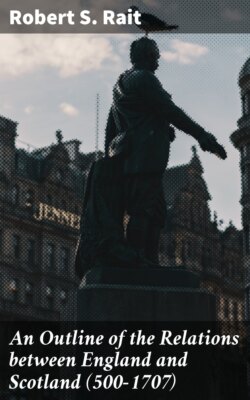An Outline of the Relations between England and Scotland (500-1707)

Реклама. ООО «ЛитРес», ИНН: 7719571260.
Оглавление
Robert S. Rait. An Outline of the Relations between England and Scotland (500-1707)
An Outline of the Relations between England and Scotland (500-1707)
Table of Contents
INTRODUCTION
FOOTNOTES:
CHAPTER I
RACIAL DISTRIBUTION AND FEUDAL RELATIONS. c. 500–1066 a.d
FOOTNOTES:
CHAPTER II
SCOTLAND AND THE NORMANS. 1066–1286
FOOTNOTES:
CHAPTER III
THE SCOTTISH POLICY OF EDWARD I. 1286–1296
FOOTNOTES:
CHAPTER IV
THE WAR OF INDEPENDENCE. 1297–1328
FOOTNOTES:
CHAPTER V
EDWARD III AND SCOTLAND. 1328–1399
FOOTNOTES:
CHAPTER VI
SCOTLAND, LANCASTER, AND YORK. 1400–1500
FOOTNOTES:
CHAPTER VII
THE BEGINNINGS OF THE ENGLISH ALLIANCE. 1500–1542
FOOTNOTES:
CHAPTER VIII
THE PARTING OF THE WAYS. 1542–1568
FOOTNOTES:
CHAPTER IX
THE UNION OF THE CROWNS. 1568–1625
FOOTNOTES:
CHAPTER X
"THE TROUBLES IN SCOTLAND"
FOOTNOTES:
CHAPTER XI
THE UNION OF THE PARLIAMENTS. 1689–1707
APPENDIX A
REFERENCES TO THE HIGHLANDERS IN MEDIÆVAL LITERATURE. I. AELRED (12th Century)
Account of the Battle of the Standard
2. JOHN OF FORDUN (d. 1394?)
(a) Description of the Highlanders
(b) Coronation of Alexander III as a king of Scots
3. BOOK OF PLUSCARDEN (written in the latter half of the 15th century)
Account of Harlaw
4. WALTER BOWER (d. 1449)
Account of Harlaw
5. JOHN MAJOR OR MAIR (1469–1550)
(a) References to the Scottish nation, and description. of the Gaelic-speaking population
(b) Account of Harlaw
6. HECTOR BOECE (1465?-1536)
(a) Account of the differences between Highlanders and Lowlanders
(b) Account of Harlaw
7. JOHN LESLEY (1527–1596)
Contrast between Highlanders and Lowlanders
8. GEORGE BUCHANAN (1506–1582)
Account of Harlaw
FOOTNOTES:
APPENDIX B
THE FEUDALIZATION OF SCOTLAND
FOOTNOTES:
APPENDIX C
TABLE OF THE COMPETITORS OF 1290
(Names of the thirteen Competitors are in bold type)
INDEX
Отрывок из книги
Robert S. Rait
Published by Good Press, 2019
.....
The writer of the present volume ventures to hope that he has, at all events, done something to make out a case for re-consideration of the subject. The political facts on which rests the argument just stated will be found in the text, and an Appendix contains the more important references to the Highlanders in mediæval Scottish literature, and offers a brief account of the feudalization of Scotland. Our argument amounts only to a modification, and not to a complete reversal of the current theory. No historical problems are more difficult than those which refer to racial distribution, and it is impossible to speak dogmatically on such a subject. That the English blood of the Lothians, and the English exiles after the Norman Conquest, did modify the race over whom Malcolm Canmore ruled, we do not seek to deny. But that it was a modification and not a displacement, a victory of civilization and not of race, we beg to suggest. The English influences were none the less strong for this, and, in the end, they have everywhere prevailed. But the Scotsman may like to think that mediæval Scotland was not divided by an abrupt racial line, and that the political unity and independence which it obtained at so great a cost did correspond to a natural and a national unity which no people can, of itself, create.
Eduard gaiff him bath Argill and Lorn".
.....